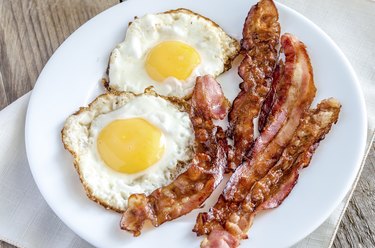
Although you may think all eggs have the same number of calories, their nutritional value depends on their size and how you cook them. Fried egg calories are significantly higher than those in boiled eggs.
Tip
According to the USDA, there are 90 calories in one large fried egg, with 6.83 grams of fat and 28.5 milligrams of calcium. Fried egg protein is around 6.26 grams.
Video of the Day
Benefits of Eggs
Eggs can play an important role in basic nutrition as they are a great source of protein, fats and micronutrients. According to a review that was published in the January 2015 issue of the journal Nutrients, eggs contain few carbs and around 12 grams of protein and 12 grams of fat per 100 grams (approximately 3.5 ounces).
Video of the Day
This high-protein food also supplies essential nutrients, such as zinc, selenium, retinol and tocopherols, which may protect against cardiovascular disease and other ailments. People who follow the typical Western diet are often deficient in these micronutrients.
According to Keck Medicine of USC, eating eggs elevates high-density lipoprotein (HDL) cholesterol levels. That's the good cholesterol. When your HDL levels are high, you have a lower risk of heart disease, stroke and other health issues. Furthermore, egg yolks contain large amounts of lutein and zeaxanthin, two antioxidants that may help prevent cataracts and macular degeneration.
Read more: 9 Things You May Not Know About Eggs
Fried Egg Calories and Nutrients
There are many ways for you to enjoy eggs, and they involve entirely different cooking methods. Depending on the cooking method you use, calorie counts and nutritional values may vary.
Fried eggs and boiled eggs supply a similar number of calories. However, fried eggs are often cooked in some sort of fat, while boiled eggs are cooked in water, which makes the former slightly higher in calories.
These two types of eggs also provide similar amounts of protein and micronutrients, such as phosphorous, selenium and vitamins A, B2, B5 and B9. A fried egg contains about 0.8 milligrams of iron, though, while one boiled egg has only 0.5 milligrams of this mineral.
Depending on what you cook your eggs in, their nutritional value can either increase or drop. If you choose to consume fried eggs regularly, it may be healthier to cook them in olive oil or avocado oil instead of butter.
How to Eat Eggs Safely
Before consuming eggs, it's important to follow some food safety practices. Fresh, uncooked eggs — even those with uncracked shells — may contain a type of bacteria called salmonella_._ This microorganism may cause food poisoning, or foodborne illness.
According to the U.S. Food and Drug Administration, Salmonella is a group of bacteria that may cause gastrointestinal illness and fever. Eggs have been involved in several outbreaks of Salmonella over the years.
To stay safe, consider these tips when buying eggs:
- Only buy eggs if sold from a refrigerator or refrigerated case.
- Before buying, open the carton to make sure that the eggs look clean and their shells aren't cracked.
- Store promptly in your refrigerator.
- Store eggs in their original carton and use them within three weeks for best quality.
When cooking, wash your hands, utensils and work surfaces with hot, soapy water before and after any contact with raw eggs. Some additional tips for preparing eggs include:
- Cook the eggs until both the yolks and whites are firm — scrambled eggs should not be runny.
- Dishes containing eggs should be cooked to 160 degrees Fahrenheit, according to FoodSafety.gov.
- If you're making a recipe that calls for raw or undercooked eggs like Caesar salad dressing, mayo or homemade ice cream, use eggs that have been treated to destroy salmonella, or pasteurized egg products.
- USDA: "Egg, Whole, Cooked, Fried"
- Nutrients: "Egg and Egg-Derived Foods: Effects on Human Health and Use as Functional Foods"
- Keck Medicine of USC: "9 Health Benefits of Eating Eggs for Breakfast"
- U.S. Food and Drug Administration: "Salmonella"
- Egg Nutrition Center: "Nutrients in Eggs"
- USDA: "Egg,Whole, Cooked, Hard-Boiled"
- U.S. Department of Health & Human Services: "Safe Minimum Cooking Temperatures Charts"